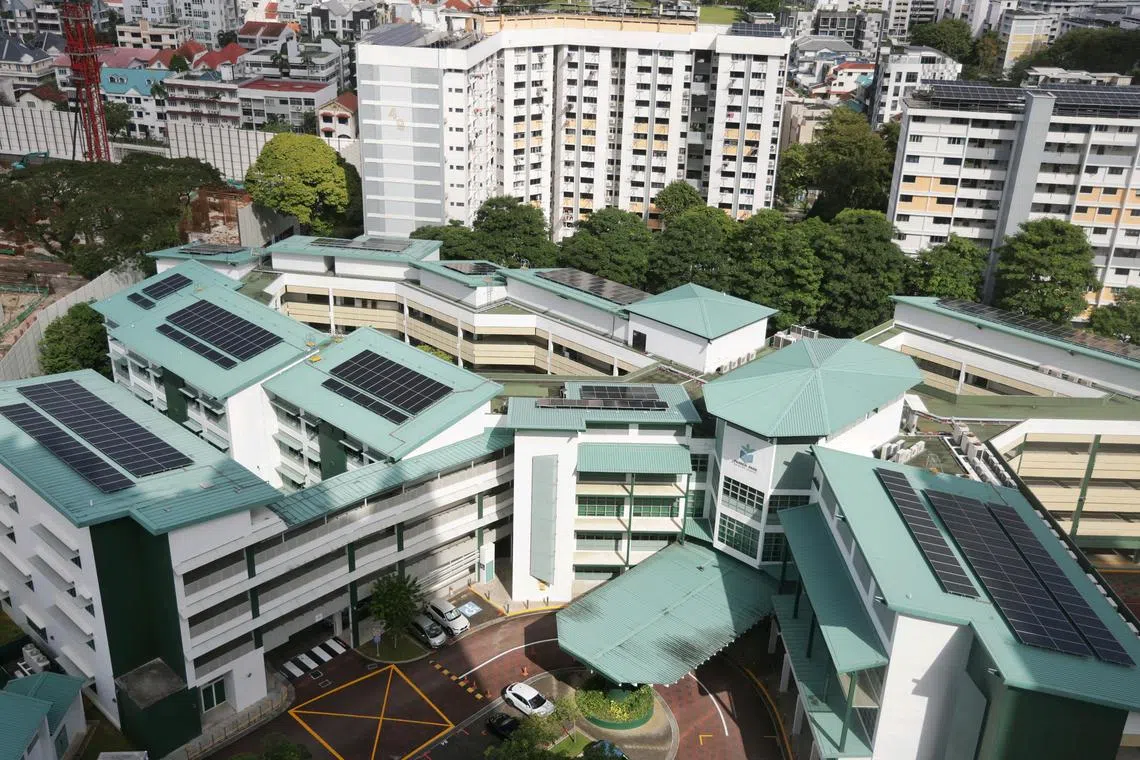Commentary
Singapore’s 2035 climate target: A commitment to act now despite waning global interest
Sign up now: Get ST's newsletters delivered to your inbox

Solar panels on the roofs of Farrer Park Primary School. Singapore is laying the groundwork for importing clean energy from its neighbours, while deploying solar panels in unusual places.
ST PHOTO: KEVIN LIM
Follow topic:
SINGAPORE – Singapore’s climate target for 2035 is not just a goal; it is a testament to the country’s commitment to act now for a sustainable future, even as the climate emergency moves further down the agendas of other countries.
Singapore has pledged to reduce its emissions to between 45 million tonnes (Mt) and 50Mt by 2035,
This new emissions target was submitted to the UN on Feb 10, the deadline the global body had set for new climate pledges. Under the Paris Agreement, the world’s climate pact, countries must set progressively more ambitious targets every five years.
Given that Singapore plans to reach net-zero emissions by 2050, the 2035 target is noteworthy as it implies a linear trajectory to meeting the longer-term goal.
A linear trajectory means that the nation’s emissions are expected to decline steadily over time, instead of registering a sharper downturn closer to mid-century.
For context, Singapore’s total greenhouse gas emissions in 2022 amounted to 58.59Mt. The Republic expects its emissions to reach a peak of 64.43Mt in 2028, before coming down to 60Mt in 2030.
Singapore is committed to tackling climate change in a few ways.
First, the linear trajectory shows its willingness to take action now to cut its emissions, instead of waiting to do more in the future, when decarbonisation technologies mature and become cheaper.
In 2021, then US climate envoy John Kerry made headlines when he said that half of the carbon reductions needed to get the world to net zero would come from technologies that have not yet been invented, and that people did not have to “give up a quality of life” to cut emissions.
His comments were criticised by climate scientists, who said there are existing technologies – such as renewable energy plants or energy efficiency initiatives – that would enable countries to start cutting emissions now.
Singapore’s 2035 target should send a clear signal to the public, businesses and investors: Despite the global headwinds on climate – the US has pulled out of the Paris Agreement, while Indonesia is considering doing so – the Republic is not letting its efforts on tackling climate change flag.
And its strategy is to tap existing technologies while investing in research on emerging ones.
For example, a significant proportion – 36.5 per cent – of Singapore’s emissions in 2022 came from the power sector.
But the Republic faces constraints in deploying renewable energy, owing to its small land area that makes the installation of large solar farms difficult. It is now laying the groundwork for importing clean energy from its neighbours, while deploying solar panels in unusual places – including water surfaces.
For the long term, Singapore is looking into emerging technologies such as small modular nuclear reactors, and assessing the viability of hydrogen, which could help cut emissions from the power sector when they become viable.
Second, the 2035 climate change target is also a sign that more emissions-cutting initiatives will be implemented in the future, with trickle-down impacts for all society.
These could include higher energy prices due to carbon taxes, the potential adoption of alternative energy forms such as nuclear, or new infrastructural developments to keep out rising seas.
As a resource-scarce country with limited access to alternative energy, the Republic acknowledged in its submission to the UN that achieving its 2035 climate target will be a challenge.
“It will require more stringent regulations, pricing and market policies to incentivise and enable all sectors of the economy to decarbonise,” Singapore said in the 31-page document. “It will also require us to invest even more in low-carbon technologies, such as hydrogen and carbon capture and storage.”
Climate change impacts, such as rising temperatures, are already being felt in the country, but Singapore’s geography has protected it from many of the harsher impacts ravaging other parts of the world, such as increasingly frequent and intense typhoons.
As a result, many people here may not see the urgency of tackling the issue, thinking it is a problem for the future.
But climate impacts are only expected to worsen, with even higher temperatures, rising sea levels, more intense bouts of rain and longer periods of dry weather. These will have real and significant impacts on the country – especially on vulnerable members of the community.
It is not just direct impacts of climate change that Singapore needs to worry about. Indirect effects, such as disrupted food supply chains owing to erratic weather, are also a concern.
National conversations will be needed on what more can be done, why Singapore is taking these steps, and the trade-offs that will affect all of us.
Finally, Singapore’s 2035 target underscores the nation’s commitment to multilateralism at a time when it seems to be breaking down.
Singapore is one of only a handful of countries that submitted its target to the UN within the deadline. As at Feb 11, only 13 of 195 countries had done so.
Moreover, Singapore’s track record has shown that it does not set climate change targets without careful planning.
For example, in 2021, even though many countries set net-zero-by-2050 targets – many of which were not backed up by concrete road maps on how to get there – Singapore held off on doing so.
It eventually submitted its net-zero target in October 2022, after a framework was put in place at the COP26 UN climate conference to allow countries to buy carbon credits from elsewhere to meet their climate change targets.
It remains to be seen how much Singapore will rely on carbon credits to meet its climate change targets, and this is an area that will be closely scrutinised by the climate community.
The use of carbon credits can be controversial because it allows an emitter to meet its climate targets not through any actual emission reductions, but by purchasing credits that offset its emissions.
But Singapore has indicated that it will take domestic action to cut its emissions.
In its latest submission, it stated that in developing the 2035 climate target, “extensive technical studies were undertaken, including an assessment of Singapore’s economy-wide mitigation potential”, though it did not provide details.
In another document, submitted to the UN in November 2024, the country outlined plans to boost industrial energy efficiency – the industrial sector contributed 49 per cent to the nation’s emissions in 2022 – and import clean energy from its neighbours.
Given the global challenges confronting climate action – rising cost of living and many countries scaling back climate action because of geopolitical conflicts and rising nationalism – I initially expected to be disappointed by Singapore’s 2035 climate change target.
But I am pleased to say I was not, and I am glad that Singapore, despite emitting only about 0.1 per cent of global emissions, is doing its part to ensure a safer, healthier planet for future generations.
Audrey Tan is an assistant news editor overseeing sustainability coverage. She has reported on the environment for more than a decade and hosts the Green Pulse podcast series.


